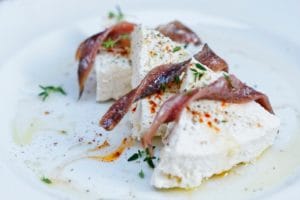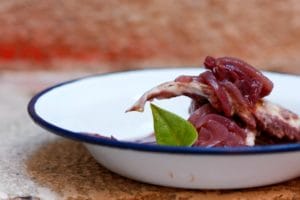Croatian cuisine shares many flavours with its Mediterranean neighbours Greece and Italy, and adds a few regional twists all its own. One aspect that often takes the uninitiated by surprise is the lively tapas culture that has evolved in towns like Split. Especially when you’re just passing through, this focus on on light meals and artful pairings provides an ideal opportunity to sample the greatest variety possible. Here are a few notes to help you understand Croatian tapas in advance of your next trip.
 Tapas restaurants may be thriving in Croatia, but the word itself is derived from the Spanish. Translating as “to cover,” the first tapas were literally slices of bread or meat served over top a drink (see our blog post on Spanish and Basque tapas for more details). Like many Mediterranean recipes, Croatian tapas dishes are often based on simple combinations of high-quality ingredients. Menu items like bruschetta, marinated anchovies, green olive paste, and cheese with fig jam create rich, harmonious flavours. Cheese is frequently a featured item, with pag cheese perhaps the most notable. The rugged island of Pag is given a light dusting of salt by sea winds, which settles on the foliage. Only hardy, aromatic plants like sage can survive this climate, so when sheep graze on the vegetation the resulting milk and cheese is uncommonly flavourful. Softer varieties, like honey-dipped cottage cheese, are also delectable and frequently served at tastings.
Tapas restaurants may be thriving in Croatia, but the word itself is derived from the Spanish. Translating as “to cover,” the first tapas were literally slices of bread or meat served over top a drink (see our blog post on Spanish and Basque tapas for more details). Like many Mediterranean recipes, Croatian tapas dishes are often based on simple combinations of high-quality ingredients. Menu items like bruschetta, marinated anchovies, green olive paste, and cheese with fig jam create rich, harmonious flavours. Cheese is frequently a featured item, with pag cheese perhaps the most notable. The rugged island of Pag is given a light dusting of salt by sea winds, which settles on the foliage. Only hardy, aromatic plants like sage can survive this climate, so when sheep graze on the vegetation the resulting milk and cheese is uncommonly flavourful. Softer varieties, like honey-dipped cottage cheese, are also delectable and frequently served at tastings.
Tapas dishes can be enjoyed on their own, though as the etymology suggests wine makes for an unparalleled accompaniment. Croatia is geographically close to Italy, and its wine is similarly excellent. Plavac Mali is a regional favourite, a full-bodied red varietal typically high in alcohol and tannins with notes of berry and pepper. Especially if you like Zinfandel, try Plavac Mali. If your taste runs more towards white wines, try the Dalmatian specialty Pošip. This crisp white pairs nicely with fish, making it a nice complement to salty tapas items like sardines and anchovies.
 Even if you’re wine connoisseur, you may be less conversant in the nuances of olive oil. Another pillar of Mediterranean culture, Croatian olive oils regularly make the list of the best in the world according to the New York International Olive Oil Competition. Cold-pressed olive oil has a pronounced flavour and can be matched with foods much like a wine. Tapas menus often include olive oil pairings with fleur de sel, balsamic vinegar, and homemade bread. If your vacation has involved some indulgent food and drink, be reassured olive oil is also quite healthy, packed with antioxidants and other beneficial compounds.
Even if you’re wine connoisseur, you may be less conversant in the nuances of olive oil. Another pillar of Mediterranean culture, Croatian olive oils regularly make the list of the best in the world according to the New York International Olive Oil Competition. Cold-pressed olive oil has a pronounced flavour and can be matched with foods much like a wine. Tapas menus often include olive oil pairings with fleur de sel, balsamic vinegar, and homemade bread. If your vacation has involved some indulgent food and drink, be reassured olive oil is also quite healthy, packed with antioxidants and other beneficial compounds.
 Another nice feature of tapas bars is that in some chefs may prepare the food before your eyes, and offer commentary on their recipe and ingredients as they do. This is perhaps the best way to get insight into the differences between olive varieties, wine pairings, etc. before digging in. For foodies looking to savour every bite, Pure Adventures can arrange tastings of Croatian delicacies to suit your unique itinerary and tastes – check out our Croatia Adventures page to start thinking about the possibilities.
Another nice feature of tapas bars is that in some chefs may prepare the food before your eyes, and offer commentary on their recipe and ingredients as they do. This is perhaps the best way to get insight into the differences between olive varieties, wine pairings, etc. before digging in. For foodies looking to savour every bite, Pure Adventures can arrange tastings of Croatian delicacies to suit your unique itinerary and tastes – check out our Croatia Adventures page to start thinking about the possibilities.

